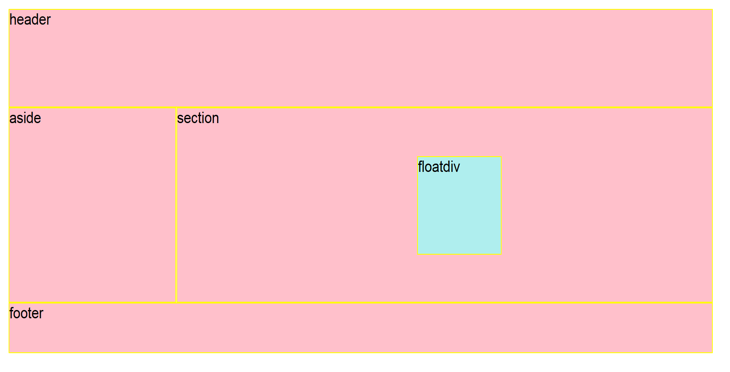
其实浮动的本意是用来解决图片和文字的排版问题,但是由于它十分好用,所以被大部分开发者应用到了网页布局中,并成为了公认布局的一种方式。
接下来,我们通过一个demo演示一下浮动和定位在网页布局中的使用,如demo1所示。
<!DOCTYPE html><html lang""en">
<head><meta charset="UTF-8"><title>浮动和定位</title></head><style type="text/css">
/*给类名为header、aside、main、footer的元素设置背景颜色和边框*/
.header, .aside, .main, .footer {
background-color:pink; /*背景色为粉色*/
border: lpx solid yellow; /·边框为1px 的黄色实线*/
}
, header {
height: 100px;
}
.aside, .main {
height: 200px;
}
.aside {
width: 200px;
float:left; /*类名为aside的元素左浮动*/
}
.main {
margin-left:202px;
/*元素左边距为202px*/ }
.footer { height: 50px:
}
/*给类名为hpat-div的元素设置背景颜色、边框、宽高及绝对定位*/
.float-div {
background-color: paleturquoise; /*背景色为苍白的宝石绿*/
border:lpx solid yellow; /·边糕为lpx的黄色实线*/
width: 100px;
height: 100px;
position: absolute: /*绝对定位*/
top:160px; /*距父元素顶部边线160px*/
left:500px; /*距父元素左边线500px*/
}
</style>
<body>
<header class="header">header</header>
<aside class="aside">aside</aside>
<section class="main">section</section>
<footer class="footer">footer</footer>
<div class="float-div">floatdiv</div>
</body>
</html>用浏监器打开demo1.页面效果如图。

在demo1中,使用浮动的知识对页面进行了布局,也就是图1-13中的header、aside、section、footer区域,然后使用绝对定位知识创建了一个浮动的div元素floatdiv。需要注意的是,position:absolute会导致元素脱离文档流,被定位的元素等于在文档中不占据任何位置,在另一个层呈现。float也会导致元素脱离文档流,但还在文档或容器中占据位置,把文档流和其他float元素向左或向右挤,并可能导致换行。